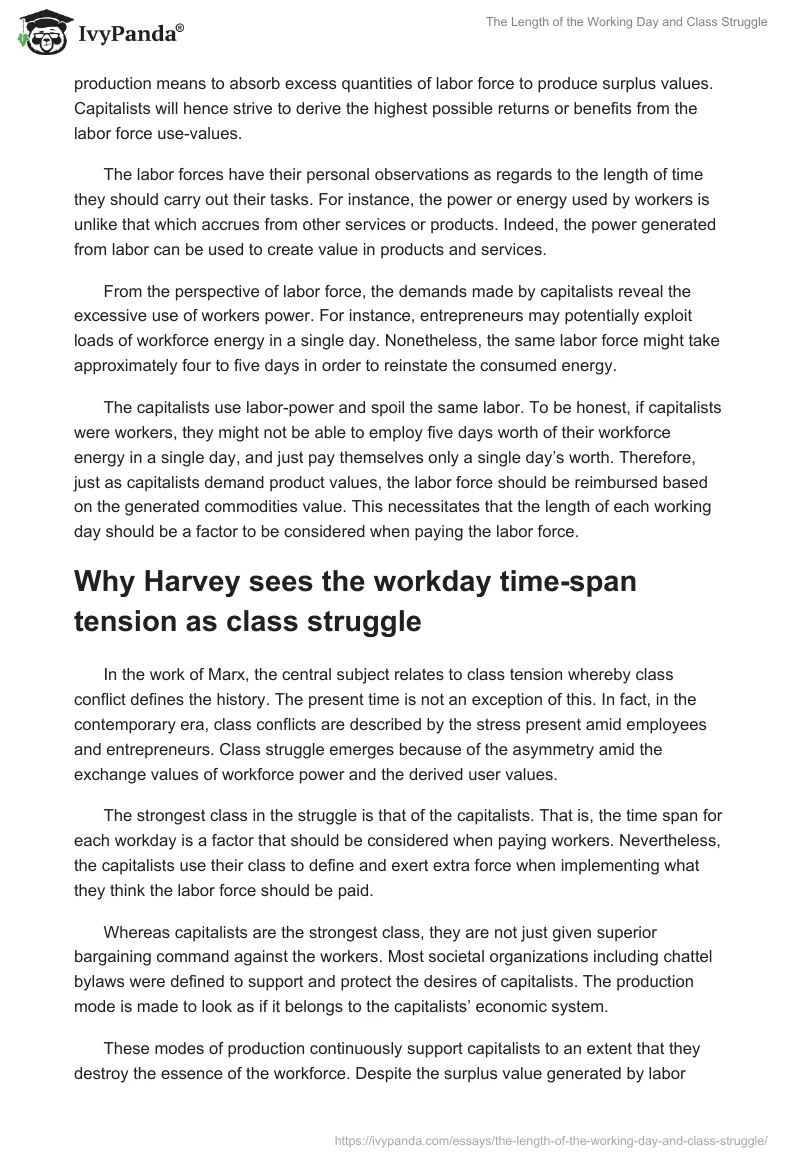The significance of each workday time-span
According to Marx, there are some levels of significance attached to the length of each working day. In fact, the power and quantity of labor should normally be purchased and consequently traded at a price that matches its worth or value. The final value derived from a product accrues from labor power. The value results from the time taken to make a product.
However, it is true that the quantity of labor force that is required to offer subsistence is hardly equivalent to the duration of each working day. The time taken to complete task and create value is more than the required workforce time. This is what translates into surplus labor as Marx claims. Therefore, the length of each workday ought to be considered as a variable quantity that adjusts in accordance with the quantity of excess labor force.
The period used in every workday can however just fluctuate within definite confines. From the capitalist system’s nature, there will always be certain levels of surplus labor. Whereas this surplus labor may approach zero limits, it cannot be an absolute zero in as much as real limits do not exist. The employees’ maximum working days are constrained or limited by both the moral constraints as well as the physical limitations, including the necessitation to accomplish other duties.
Thus, with respect to the length of working days, capitalists appear to derive some mutual benefits when they compel the labor force to toil an extra mile to generate additional product value. This implies that, all capitalists will normally materialize as capital embodied. The essence of capitalists will just resemble the capital soul, and it will not assume any other attribute.
Regardless of being aware of the needs of each labor force, capitalist are less concerned about the benefits derived by workforce when they extend the span of time worked every day. Capital has a distinctive attribute. Its drive is to compel the production means to absorb excess quantities of labor force to produce surplus values. Capitalists will hence strive to derive the highest possible returns or benefits from the labor force use-values.
The labor forces have their personal observations as regards to the length of time they should carry out their tasks. For instance, the power or energy used by workers is unlike that which accrues from other services or products. Indeed, the power generated from labor can be used to create value in products and services.
From the perspective of labor force, the demands made by capitalists reveal the excessive use of workers power. For instance, entrepreneurs may potentially exploit loads of workforce energy in a single day. Nonetheless, the same labor force might take approximately four to five days in order to reinstate the consumed energy.
The capitalists use labor-power and spoil the same labor. To be honest, if capitalists were workers, they might not be able to employ five days worth of their workforce energy in a single day, and just pay themselves only a single day’s worth. Therefore, just as capitalists demand product values, the labor force should be reimbursed based on the generated commodities value. This necessitates that the length of each working day should be a factor to be considered when paying the labor force.
Why Harvey sees the workday time-span tension as class struggle
In the work of Marx, the central subject relates to class tension whereby class conflict defines the history. The present time is not an exception of this. In fact, in the contemporary era, class conflicts are described by the stress present amid employees and entrepreneurs. Class struggle emerges because of the asymmetry amid the exchange values of workforce power and the derived user values.
The strongest class in the struggle is that of the capitalists. That is, the time span for each workday is a factor that should be considered when paying workers. Nevertheless, the capitalists use their class to define and exert extra force when implementing what they think the labor force should be paid.
Whereas capitalists are the strongest class, they are not just given superior bargaining command against the workers. Most societal organizations including chattel bylaws were defined to support and protect the desires of capitalists. The production mode is made to look as if it belongs to the capitalists’ economic system.
These modes of production continuously support capitalists to an extent that they destroy the essence of the workforce. Despite the surplus value generated by labor force after working for longer hours, it is difficult to find that the capitalists are behaving differently. The amount given to workforce as a representation of their efforts remains the same, hence causing tensions amongst these two groups.
Gaining surplus values and improving products worth are the desires and essence of the capitalists. All capitalists realize these goals via exploiting the workforce through failing to offer them the recommended payments for the complete value package on what has been produced.
As a result, there is a structural struggle involving capitalists and labor force given that capitalists are compelled to exploit to survive. Any system that belongs to the capitalists necessitates the exploitation of the workforce. There are measures taken to reduce the hardships faced by employees.
These include welfare and minimum remuneration packages. Nevertheless, these measures are just assumed as financial aid. In reality, the financial aids are not meant to cover the time taken to generate surplus value. It is hard to change what capitalists think or believe, and so is it the case with the labor force.


